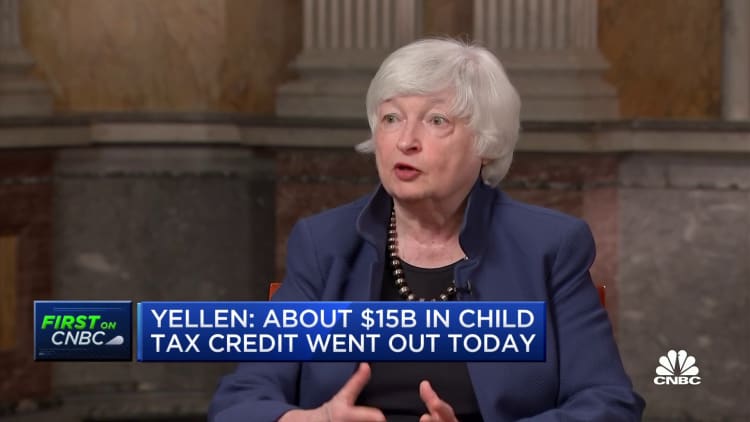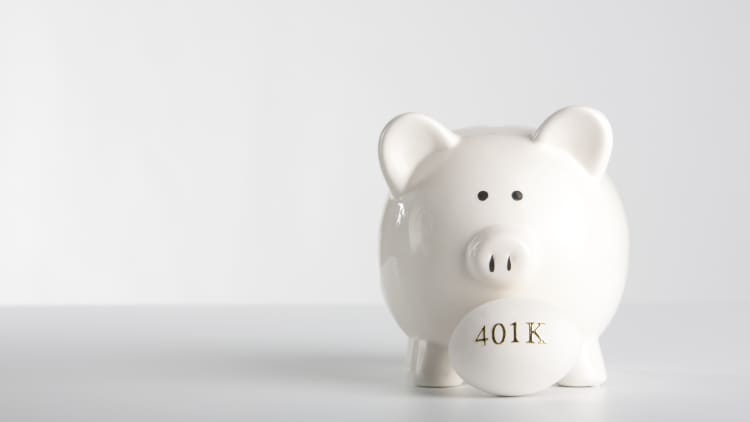It's an exciting week for millions of children and their families across the U.S.
On July 15, the first payment from the new expanded child tax credit will be sent to some 39 million families with about 65 million kids, according to the IRS.
Even though there has been months of preparation for families to become familiar about the credit, there's still confusion about it, according to a recent survey by Ally Bank. Nearly half of those asked were not sure if they qualified, and one-quarter are unsure how to access the credit, according to the report.

"If you're a parent, my advice is to take a moment now and check whether you're eligible, and if so, verify how much of a child tax credit payment you might receive," said Anand Talwar, deposits and consumer strategy executive at Ally Bank, in an email. "That way, you can plan and plan well."
What is the enhanced child tax credit?
The enhanced tax credit was established in March, when President Joe Biden signed the American Rescue Plan. For 2021, the maximum credit is $3,600 for children younger than age 6 and $3,000 for those between 6 and 17.
Half of the credit will be distributed as an advance on 2021 taxes in six monthly installments. For households getting the full benefit, those payments will be $300 per month for children under the age of 6 and $250 for those between the ages of 6 and 17.
There's no limit on the number of children who can receive the credit per family.
More from Invest in You:
Some families may want to opt out of child tax credit payments
This researcher hopes to change Biden's mind about student loan forgiveness
As travel demand surges and prices rise, 7 saving tips for this summer
Who qualifies for the maximum credit?
Most American families qualify for some amount of money.
The full credit is available to married couples with children who file taxes jointly and have adjusted gross income less than $150,000, or $75,000 for individuals. The credit phases out for taxpayers who make more money and ceases for individuals earning $95,000 and married couples earning $170,000 filing jointly.
Taxpayers who make more than that will still be eligible for the regular child tax credit, which is $2,000 per child under age 17 for families making less than $200,000 annually, or $400,000 for married couples.

What do I need to do?
Most families who have filed their taxes don't have to do anything. The IRS will use 2020 tax returns to determine eligibility, or 2019 returns for those who haven't yet filed for last year.
In addition, nonfilers who used the IRS nonfiler tool in 2020 to register eligible family members for stimulus payments will be automatically enrolled for the child tax credit.
In June, the agency sent some 36 million letters to families who may be eligible for the credit and monthly payments. Later in the month, it sent another letter stipulating how much money families are set to receive. The agency also has an online eligibility tool that's available in English and Spanish where families can check to see if they are entitled to the credit.
Some families will have to take additional action to get the credit, or to ensure they get the full amount they're entitled to. Those who don't traditionally file taxes because they don't have enough income, but have children who are eligible, can register through the IRS nonfilers' tool.
Families also can check if they're signed up for direct deposit and see what account the money will go to through the IRS Child Tax Credit Update Portal. They can also sign up for direct deposit or change their bank account through the portal, as well as see payment history.
In August, people will be able to update their mailing address, and at some point, they will be able to revise information such as marital status, income, dependents and reenroll if they'd previously unenrolled.
How will payments be sent?
Like stimulus checks, most of the monthly child tax credit payments will be sent by direct deposit — 80% of those eligible will get the money this way, according to the IRS.
If the IRS has direct deposit information from your tax return, that is likely how you'll receive the monthly credit. If you don't have direct deposit, the agency will also be sending paper checks to some families and in the future may also send payments on debit cards.

When will future payments be sent?
All advance payments will be made on the 15th of each month, unless the 15th falls on a weekend or holiday, at which point the money will be sent on the closest business day. After the benefit first goes out July 15, families can expect subsequent payments on Aug.13, Sept. 15, Oct.15, Nov. 15 and Dec. 15, according to the IRS.
So far, the monthly payments are only scheduled to continue through the end of 2021. Families will receive the second half of the credit when they file their 2021 taxes in 2022. But that could change — President Biden and other lawmakers have suggested making the enhanced credit available for additional years, or even permanent.
Can I opt out? What happens if I do?
Families can opt out of receiving the monthly payments for the credit through the Child Tax Credit Update portal. Those who do this won't get the monthly amounts but will still receive the full credit they are eligible for when they file their 2021 taxes.
Some families may choose this route because they don't need the monthly payments immediately or prefer to get a lump sum as a tax refund, said Elaine Maag, a principal research associate at the Urban-Brookings Tax Policy Center.
"There's evidence that shows that some people really like getting that large tax refund, and can use it as an opportunity to purchase a household item like a refrigerator or put together first and last month's rent so they can move," she said.
Taking the credit all at once could also offset taxes owed for families who are anticipating a tax bill.
It's too late to unenroll for the first monthly payment, but families can still tell the IRS not to send the money in the future. The last day to opt out of the next payment, due in August, is Aug. 2.
To see how much you could expect, personal finance website Grow created a calculator that factors in your filing status, annual income and the number of dependents you have.
SIGN UP: Money 101 is an 8-week learning course to financial freedom, delivered weekly to your inbox.
CHECK OUT: How to make money with creative side hustles, from people who earn thousands on sites like Etsy and Twitch via Grow with Acorns+CNBC.
Disclosure: NBCUniversal and Comcast Ventures are investors in Acorns.






